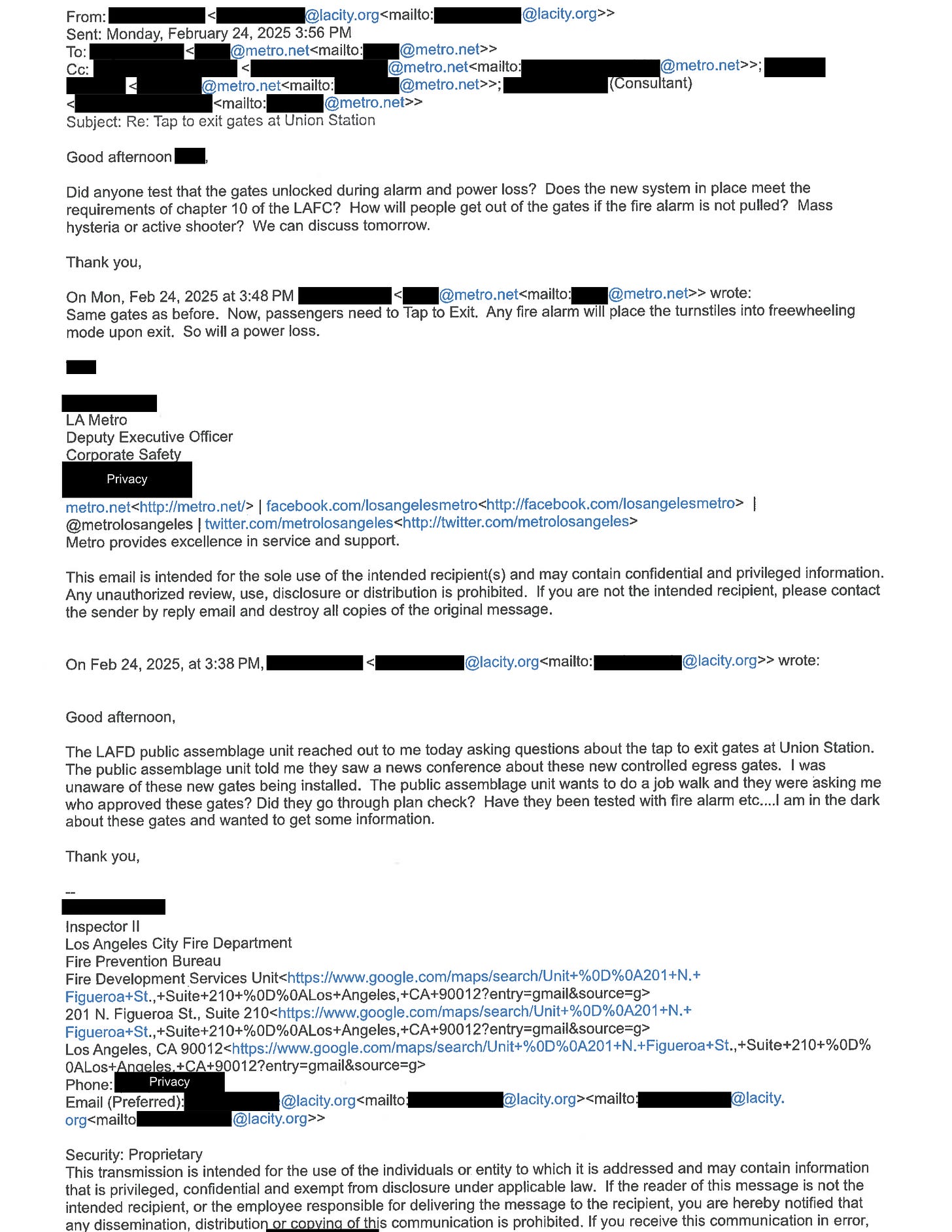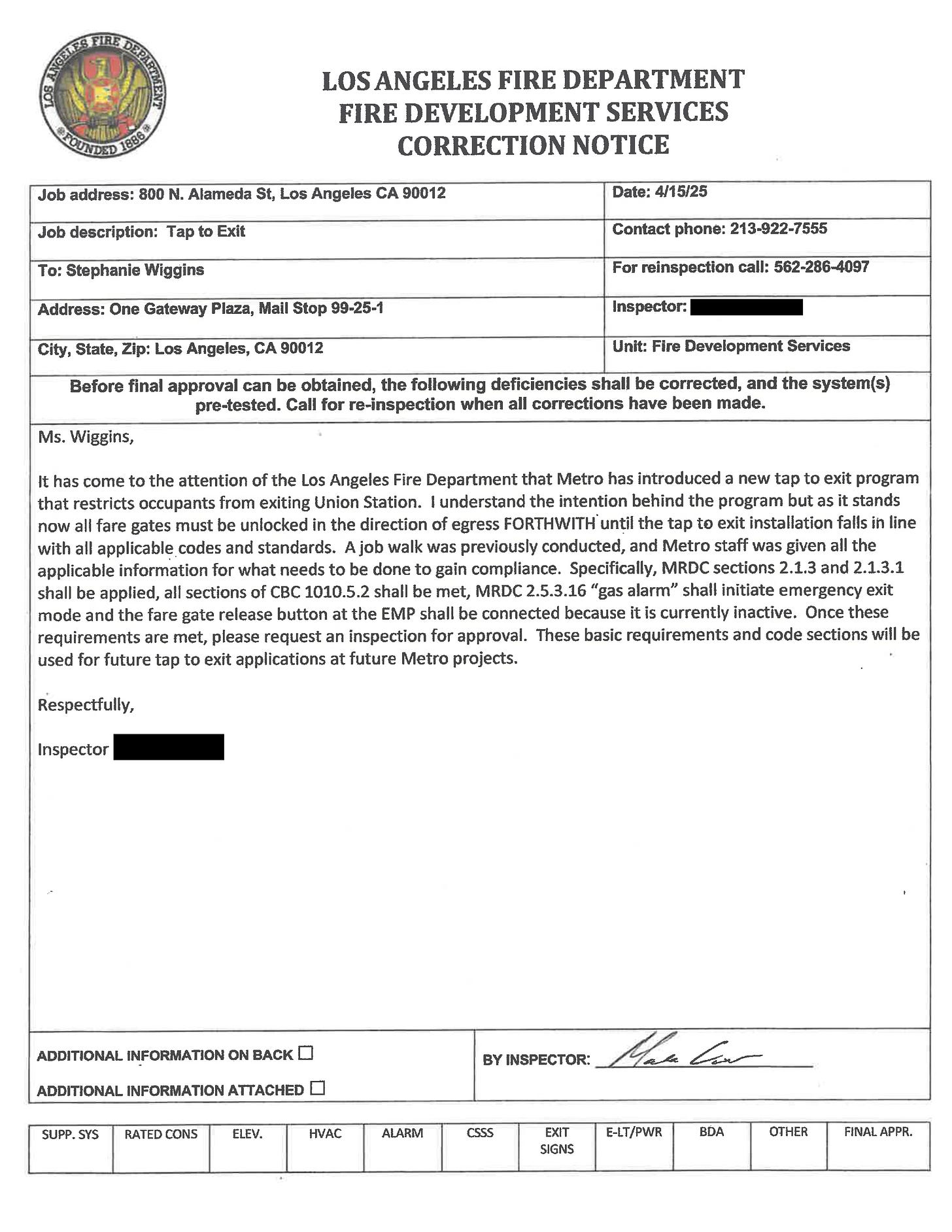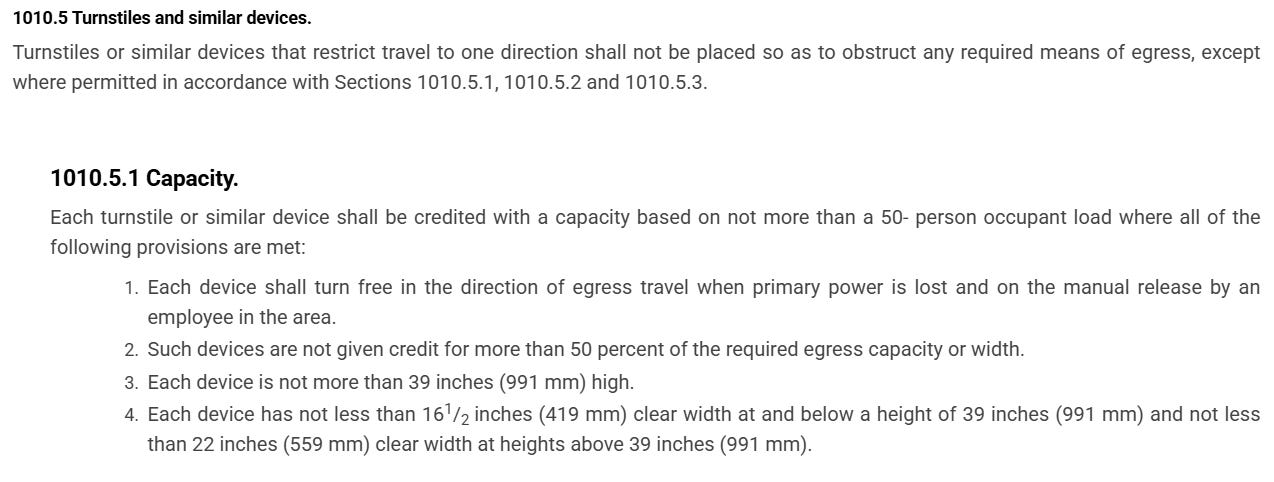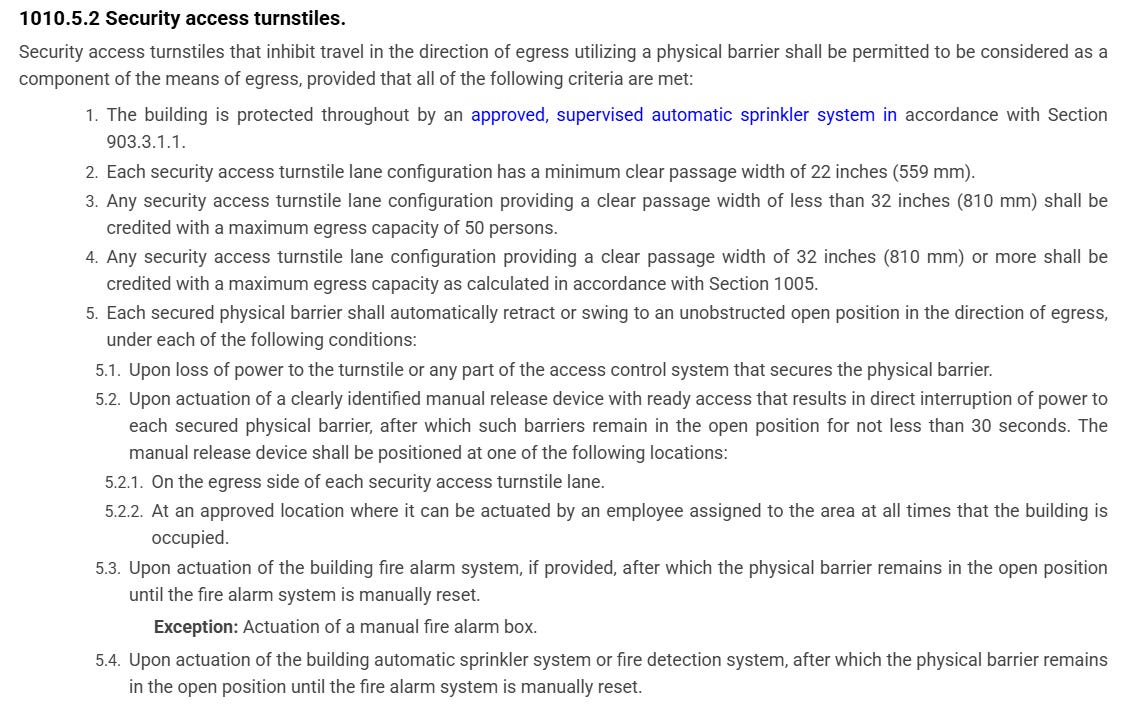LAFD Compliance: Why did Metro pause Tap-to-Exit?
What internal emails reveal about the issues that forced Metro to pause the program.

Metro’s Tap-to-Exit program has been paused since April 10, disrupting Metro’s plans to expand the program to all end-of-line stations by the end of the year.
Since the initial pause, there’s been sparse communication about the state of the program. In the July 2025 Station Experience Updates board report, it was mentioned that the pause was placed at the request of the Los Angeles City Fire Department. This explained why the program continued at Downtown Santa Monica, which is outside of LAFD’s jurisdiction, but not at Union Station or North Hollywood.
Then, in a presentation early this month, we learned that Metro submitted a “Request for Modification” for LAFD to approve the program within their jurisdiction, with additional faregate technical diagrams in the works for North Hollywood. This culminated in the reactivation of the program at North Hollywood on September 25th, reported by several users on forums and online communities.
To find the specific reasons for the pause, The SoCal Transiteer obtained several internal emails that paint a more transparent picture of the issues with the pilot.
The Initial Pause
A few days after Tap-to-Exit launched at Union Station on February 18, Metro received an email from a LAFD fire inspector. They noted that the LAFD Public Assemblage Unit, responsible for fire safety regulation enforcement in large gathering places, had contacted him after becoming aware of the program’s launch at Union Station.
After asking about approval of the program and testing, the chain continues into scheduling for a job walk the following week, March 3rd. The LAFD inspector noted that they would have to test the fire alarm to ensure the gates were inactive when the fire alarm was pulled. The rest of the chain is not included in the above screenshot, in the interest of brevity.
Later, internal emails show that Metro was planning for that scheduled LAFD inspection. The emails revealed a major concern for the program: the case of a mass hysteria event, such as an active shooter threat.
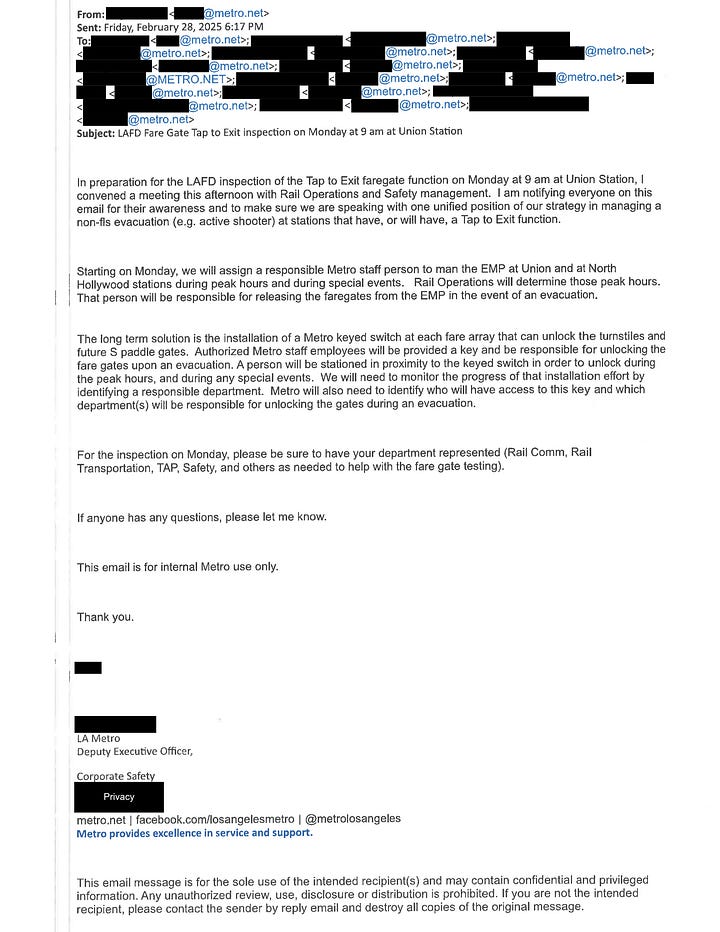
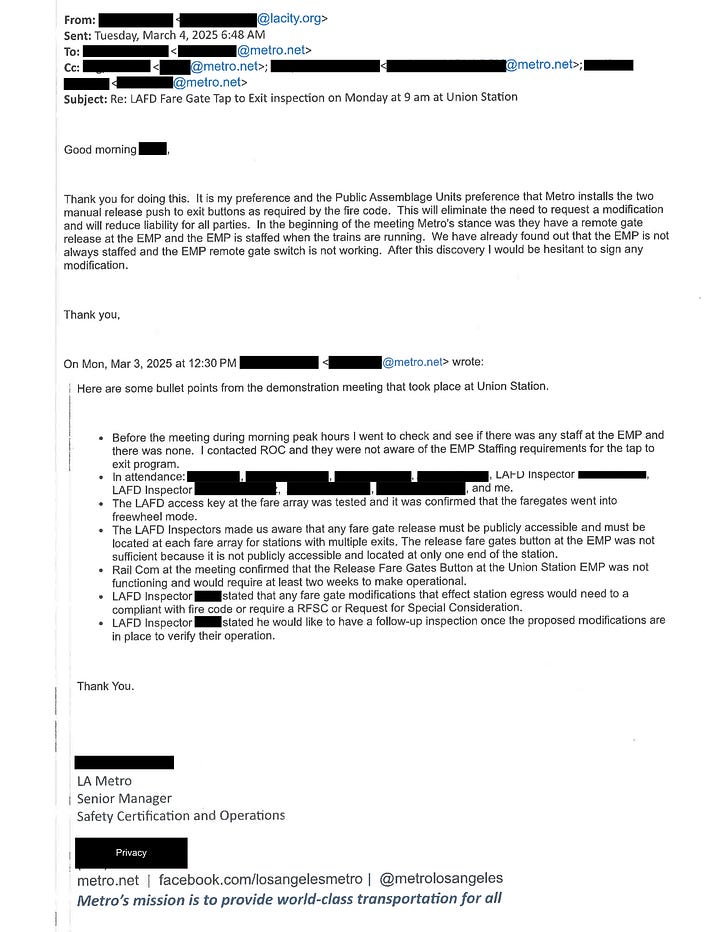
There’s a reason the Tap-to-Exit program is more of a concern for a mass hysteria event than, for example, a fire threat. When a fire alarm is pulled or triggered elsewhere, the gates automatically unlatch, as mentioned in the first email chain. On the other hand, in the case of an active shooter event, the gates would still be in Tap-to-Exit mode, absent someone pulling the fire alarm.
The email also discusses the strategies Metro would be taking in order to ensure compliance with the fire code. Part of the code requires adequate egress capacity, and since gates are included in calculations for exit capacity (NFPA 130), having the turnstiles latched means the total egress capacity would decrease, and potentially not be up to code. To mitigate this, Metro stated they would have staff stationed at the EMP (Emergency Management Panel) at Tap-to-Exit stations to ensure the faregates could be released in case of an emergency.
Furthermore, in the future, each faregate array is planned to have an emergency key slot, which can unlock all gates in the case of an emergency. Metro would station a responsible staff member to monitor these gates during peak hours, ensuring adequate egress capacity during an emergency.
A follow-up email after the meeting stated the results of the inspection. The email noted that although the LAFD key worked, there were several issues with the setup. First, the EMP didn’t have the dedicated staff member mentioned before, and the Tap-to-Exit deactivation button wasn’t operational at Union Station. Furthermore, LAFD inspectors noted that the EMP button wasn’t sufficient, due to its remoteness from the fare gate arrays.
Despite being told by LAFD that the setup for Tap-to-Exit didn’t meet the fire code, Metro appears to have continued the program. About a month after the inspection, on April 10, Metro received an email from LAFD advising them to immediately cease the program or a violation would be filed.

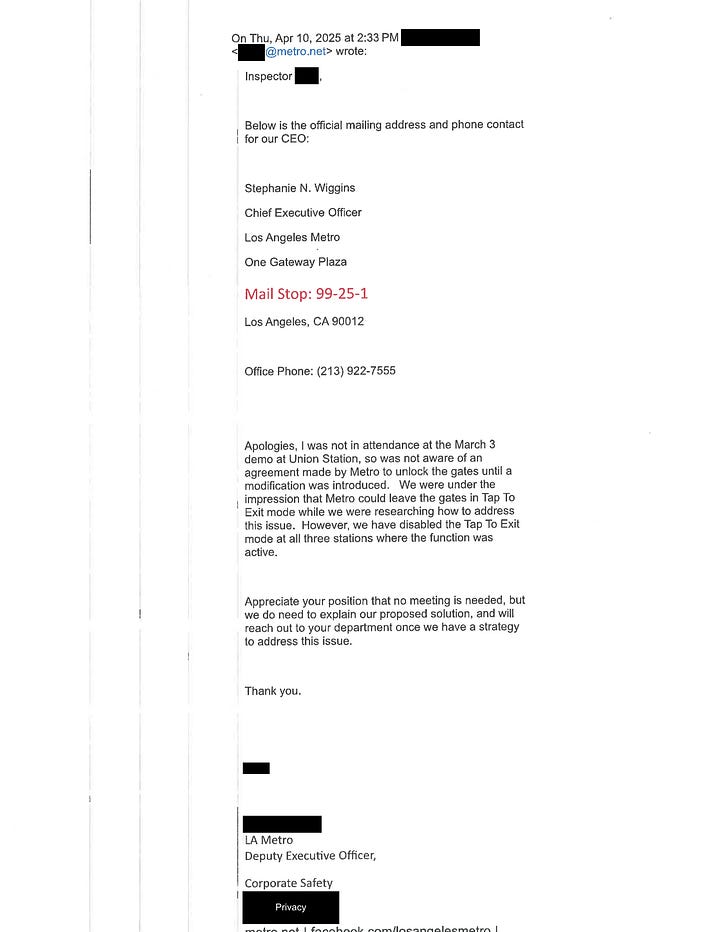
The LAFD inspector, on vacation, stated that they expected that the program would’ve been paused until the issues from the initial inspection had been corrected. After receiving this email, a Metro employee replied, saying that they had paused the program. This directly aligns with the date that the public first saw the program paused: April 10.
A few days after Metro paused the program, LAFD sent the following ‘Correction Notice’ to Metro’s CEO, Stephanie Wiggins. In it, the LAFD inspector details the exact codes needed to approve the Tap-to-Exit program for use at each station.
A more in-depth look at what exactly these codes are will be given later on, but for now, here’s a copy of the notice:
Analyzing fire codes
In total, there were three codes mentioned in the emails sent by LAFD. In the ‘Correction Notice,’ LAFD notes sections from the California Building Code and sections from the MRDC (Metro Rail Design Criteria). On top of these codes, LAFD also noted in a separate email that they expected Metro to comply with NFPA 130, which is a set of fire safety standards made for rail transit systems.
Looking at the 2012 MRDC on Skansa’s website (a Metro subcontractor), sections 2.1.3 and 2.1.3.1 simply state that all Metro projects must conform to local, state, and federal codes.
Furthermore, the other mentioned MRDC section, 2.5.3.16, is below.
Additionally, under the California Building Code, all buildings must calculate egress capacity and design their buildings to allow the maximum number of people within them to exit safely and securely. Before the Tap-to-Exit program, turnstiles at stations were counted towards the egress requirement. Those turnstiles fell under CBC 1010.5.1:
Because the turnstiles became latched in both directions as part of the Tap-to-Exit program, they essentially became ‘security access turnstiles’ covered under a different part of the CBC. Security access turnstiles fall under 1010.5.2, which has additional requirements.
Of particular interest is CBC section 1010.5.2 subsection 5. These are the requirements under which the Tap-to-Exit mode must automatically deactivate. The gates already unlatch upon loss of power, when the fire alarm is triggered, or any other aspect of the fire alarm system. However, under subsection 5.2, there must be a manual release device to allow the turnstiles to spin freely in an emergency.
This was one of the issues identified in the original email chain by LAFD. The two issues raised by LAFD for the Tap-to-Exit program were the lack of this manual release device and the egress capacity requirement.
Working on a solution
Among several other emails received by The SoCal Transiteer were progress updates on efforts to get the program back on track. For brevity, they won’t be linked here, but a copy of the emails is available upon request.
On May 14th, the Rail Communications team was able to repair the EMP (Emergency Management Panel) at Union Station, enabling the ‘Release Faregate’ button, which would deactivate the Tap-to-Exit mode at both the East and West turnstile arrays. Next, on June 6th, the RFM (Request for Modification) was submitted to both LAFD Chief Perez and the original LAFD fire inspector.
LAFD did not provide a copy of the RFM, but three attachments were included in the photocopy of the sent email. Although these files exist, they were not provided as part of the original public records request.
Final approval was received for the North Hollywood Tap-to-Exit program on September 25th. There was no mention of a timeline for the return of Tap-to-Exit at Union Station.
Impacts of the pause
In the first month after the program was paused, there were some considerable impacts across the system. In a board report from July, Metro staff noted that when comparing the period before the program was paused to the period after:
Union Station saw a +116% increase in reported security incidents
North Hollywood saw a +67% increase in reported security incidents
LAPD crime data has shown increased narcotics activity on the B Line
Fare revenue has dropped nearly -$35,000 in the first month of TAP-to-Exit suspension across these two stations
A Metro spokesperson provided the following statement when asked for comment regarding the pause:
Since its introduction in North Hollywood in May 2024, the TAP-to-Exit pilot has been tremendously effective at increasing fare compliance and decreasing crime on the system. In North Hollywood, for example, it transformed behavior along the 14 B-Line stations with reported crime and other issues (fights, drug use and graffiti) having dropped by more than 40 percent on the Transit Watch app. Then, when it was expanded to Downtown Santa Monica, incidents on the E Line dropped by 55% when TAP-to-Exit was paired with fare enforcement.
As Metro continues its discussions with the Los Angeles Fire Department over the best way to implement our TAP-to-Exit program, our Transit Security Officers are still working to deter fare evaders at stations within the City of Los Angeles. The successful program continues within the City of Santa Monica.
As Metro continues its ambitious plans to expand the Tap-to-Exit program to all end-of-line stations, there will be several changes moving forward. Metro will likely be working more closely with local fire departments, coordinating with LAFD to reinstate the program at Union Station and, at the same time, working with LACoFD to expand it to the new Pomona (North) station.
If you found this article interesting, consider subscribing to The SoCal Transiteer! You can customize what topics you want to read about, and it’s the best way to support our work.


